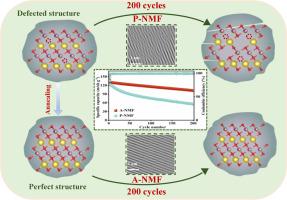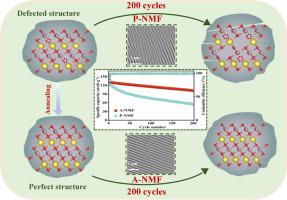Perfecting oxygen stoichiometry in cathode materials: A defect-control strategy for stable sodium-ion batteries
IF 20.2
1区 材料科学
Q1 CHEMISTRY, PHYSICAL
引用次数: 0
Abstract
The practical application of NaNi1/3Mn1/3Fe1/3O2 (NMF) is limited by irreversible phase transitions that lead to structural degradation, as well as pronounced air sensitivity. To address these challenges, we propose a protocol leveraging low-temperature annealing to engineer a defect-suppressed cathode architecture with tailored oxygen vacancies (OVs), as validated using neutron powder diffraction (NPD) and a series of characterizations. This approach remarkably improved lattice oxygen framework stability and promotes ionic charge redistribution within the crystal lattice. Additionally, the engineered material displays enhanced covalency of transition metal-oxygen bonds (TM-O) and optimized ionic transport pathways. As a result, modified material exhibits enhanced electrochemical stability, such as more stable cyclability, and smaller voltage hysteresis, etc. In situ and ex situ characterizations (e.g. XRD, XPS, SEM) reveal a highly ordered lattice, correlating with a robust and resilient crystal structure. This work establishes a defect-engineering paradigm to design high-stability layered oxide cathodes through modifying intrinsic OVs, addressing both bulk structural integrity and interfacial compatibility challenges in sodium-ion battery systems. Furthermore, the simple prolonged low-temperature annealing strategy not only enhances material performance in a cost-effective way but also promotes the commercial application of sodium-ion batteries.


完善正极材料中的氧化学计量:稳定钠离子电池的缺陷控制策略
NaNi1/3Mn1/3Fe1/3O2 (NMF)的实际应用受到导致结构降解的不可逆相变以及明显的空气敏感性的限制。为了解决这些挑战,我们提出了一种利用低温退火来设计具有定制氧空位(OVs)的缺陷抑制阴极结构的方案,并通过中子粉末衍射(NPD)和一系列表征进行了验证。这种方法显著提高了晶格氧骨架的稳定性,促进了晶格内离子电荷的再分配。此外,该工程材料显示出增强的过渡金属-氧键(TM-O)共价和优化的离子传输途径。结果表明,改性后的材料表现出更强的电化学稳定性,如更稳定的循环性能、更小的电压滞后等。原位和非原位表征(例如XRD, XPS, SEM)显示出高度有序的晶格,与坚固和弹性的晶体结构相关。这项工作建立了一个缺陷工程范例,通过修改固有的OVs来设计高稳定性的层状氧化物阴极,解决了钠离子电池系统中整体结构完整性和界面兼容性的挑战。此外,简单的长时间低温退火策略不仅以经济有效的方式提高了材料的性能,而且促进了钠离子电池的商业化应用。
本文章由计算机程序翻译,如有差异,请以英文原文为准。
求助全文
约1分钟内获得全文
求助全文
来源期刊

Energy Storage Materials
Materials Science-General Materials Science
CiteScore
33.00
自引率
5.90%
发文量
652
审稿时长
27 days
期刊介绍:
Energy Storage Materials is a global interdisciplinary journal dedicated to sharing scientific and technological advancements in materials and devices for advanced energy storage and related energy conversion, such as in metal-O2 batteries. The journal features comprehensive research articles, including full papers and short communications, as well as authoritative feature articles and reviews by leading experts in the field.
Energy Storage Materials covers a wide range of topics, including the synthesis, fabrication, structure, properties, performance, and technological applications of energy storage materials. Additionally, the journal explores strategies, policies, and developments in the field of energy storage materials and devices for sustainable energy.
Published papers are selected based on their scientific and technological significance, their ability to provide valuable new knowledge, and their relevance to the international research community.
 求助内容:
求助内容: 应助结果提醒方式:
应助结果提醒方式:


